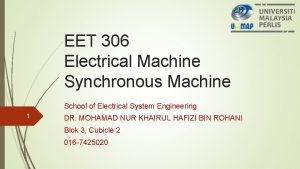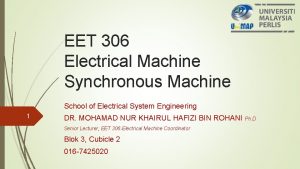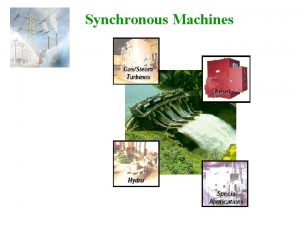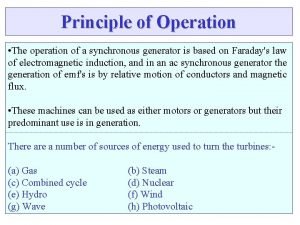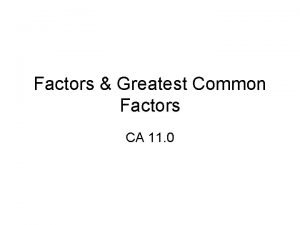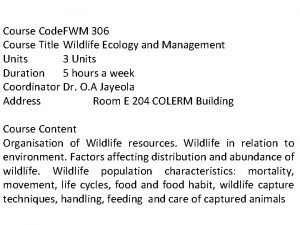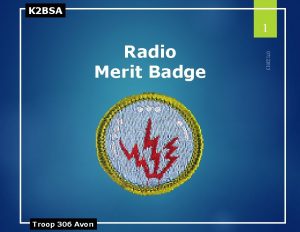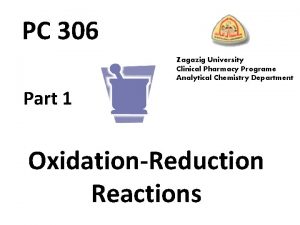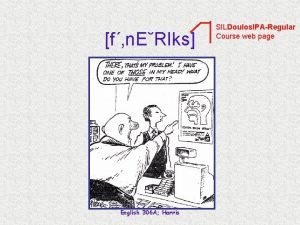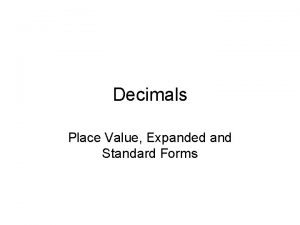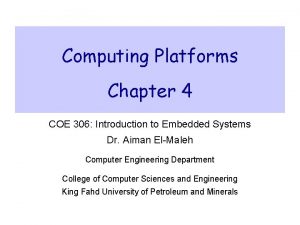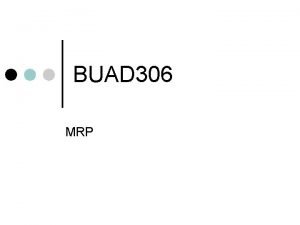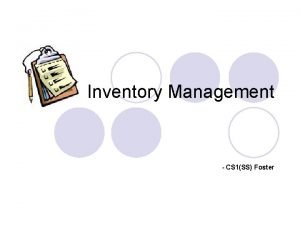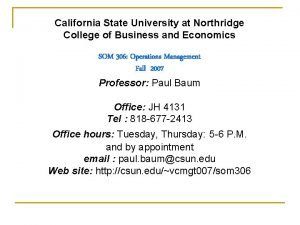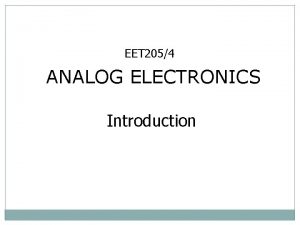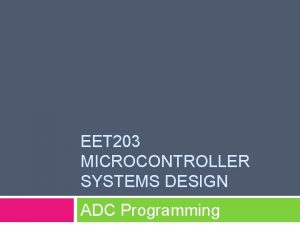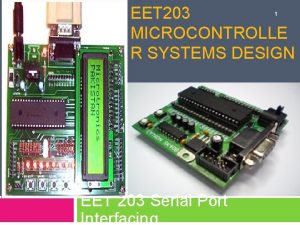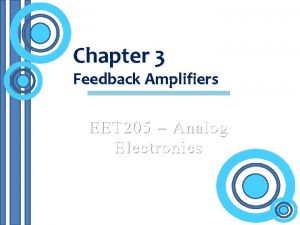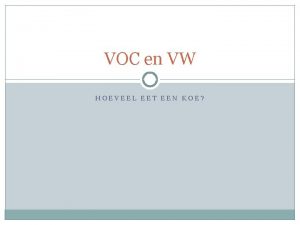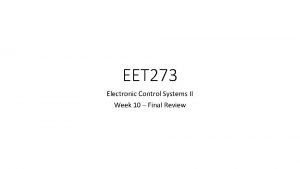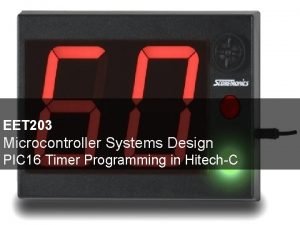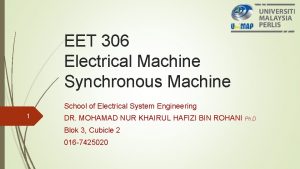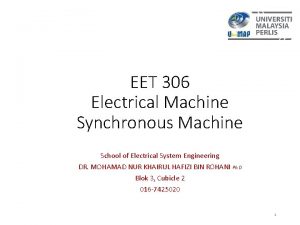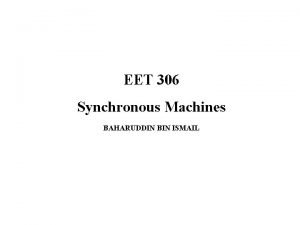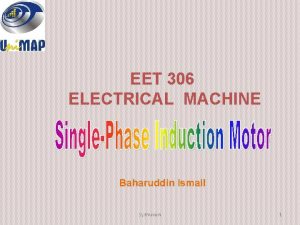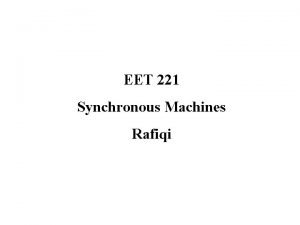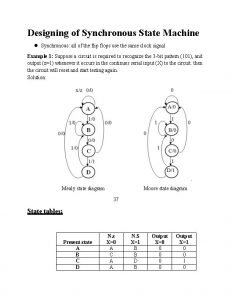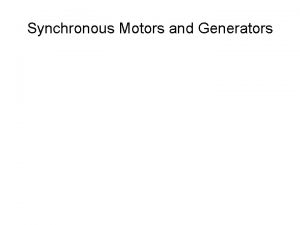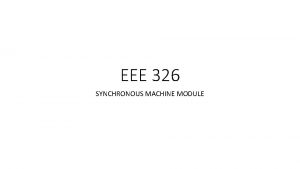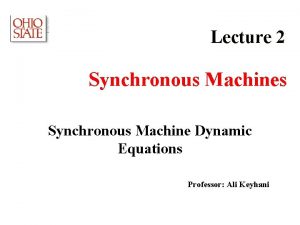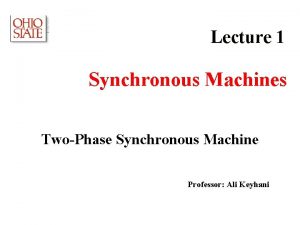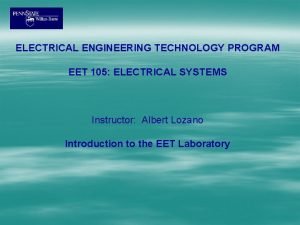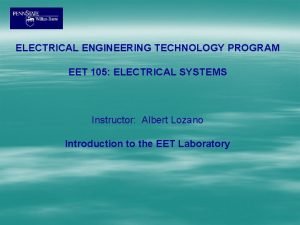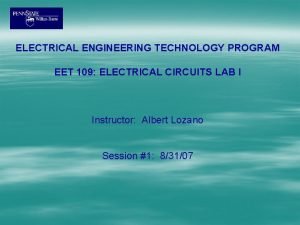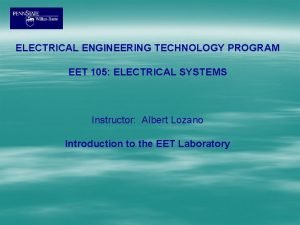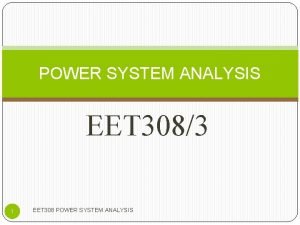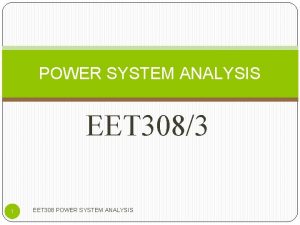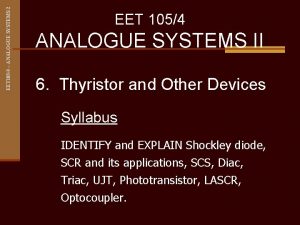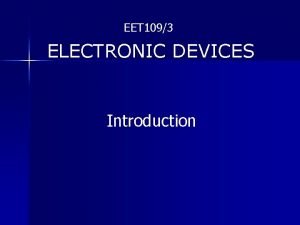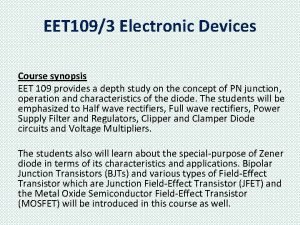EET 306 Electrical Machine Chapter 4 Synchronous Machine



































- Slides: 35

EET 306 Electrical Machine ~Chapter 4: Synchronous Machine~ School of Electrical System Engineering Puan (Mrs. ) Ami Nurul Nazifah binti Abdullah Blok 6, Bilik 6 -1 -A 014 - 516 8545 Facebook : ‘Puan Ami Nazifah’ *(this account for student only)

Doa mula kelas “Ya Tuhan, lapangkanlah dadaku, mudahkanlah segala urusanku, dan lepaskanlah kekakuan lidahku, agar mereka mengerti perkataanku. ” (Thaha: 27) AMI NURUL NAZIFAH ABDULLAH

Chapter 4: Synchronous Machine 4. 1 4. 2 4. 3 Sync. G : Constructional features & operation theory Sync. G : Basic parameter Sync. G : Parallel operation of AC Generators 4. 3. 1 Synchronization 4. 3. 2 Active and reactive power sharing between parallel generator. 4. 4 Sync. M : Principle operation 4. 4. 1 Basic Principle. 4. 4. 2 Method of starting. 4. 4. 3 Motor on load. AMI NURUL NAZIFAH ABDULLAH

4. 3 Sync. G : Parallel operation of AC Generators 4. 3. 2 ACTIVE AND REACTIVE POWER SHARING BETWEEN PARALLEL GENERATOR. q Introduction as Stand Alone: • When the generator is loaded – power is drawn from the mechanical system – the generator applies a torque which opposes the direction of motion of the mechanical system – As a result, the generator tends to slow down the mechanical system. • Changing mechanical speed is undesirable, as it results in a change in the frequency of the induced voltages. • For this reason, a "governor" is applied to the mechanical system to make the change in speed predictable with power changes.

4. 3 Sync. G : Parallel operation of AC Generators 4. 3. 2 ACTIVE AND REACTIVE POWER SHARING BETWEEN PARALLEL GENERATOR. q Introduction as Stand Alone (Cont’d): • The governor or speed limiter sets the no-load speed and controls the reduction in speed so that the frequency-power relationship is linear: Figure : The plots show the linear reduction in speed as the power drawn from the mechanical system increases. • If the frequency of the generated voltages is too low, the frequency can be increased by increasing the no-load speed of the mechanical governor.

4. 3 Sync. G : Parallel operation of AC Generators 4. 3. 2 ACTIVE AND REACTIVE POWER SHARING BETWEEN PARALLEL GENERATOR. q Introduction as Stand Alone (Cont’d): • Mathematically, the changes in frequency with load are described using two quantities, the Speed Droop, SD and the slope of the power-frequency plot, Sp. • Speed Droop, SD is defined as • Typical values for speed droop are in the range 2% - 4%

4. 3 Sync. G : Parallel operation of AC Generators 4. 3. 2 ACTIVE AND REACTIVE POWER SHARING BETWEEN PARALLEL GENERATOR. q Introduction as Stand Alone (Cont’d): • The power from the generator can be found using: where; f. NL = no load operation fsys = operating system frequency • The slope Sp is often quoted in k. W/Hz or MW/Hz.

4. 3 Sync. G : Parallel operation of AC Generators 4. 3. 2 ACTIVE AND REACTIVE POWER SHARING BETWEEN PARALLEL GENERATOR. q Introduction as Stand Alone (Cont’d): • The effect of changes to terminal voltage with reactive load can be plotted on a diagram similar to the f-P plot; Figure : The plots show the linear reduction in voltage as the reactive-power drawn from the mechanical system increases. • Increasing the inductive load on the generator reduces the terminal voltage, adding capacitance increases the terminal voltage. Reductions to the terminal voltage can be compensated by increasing the no load voltage (|E|).

4. 3 Sync. G : Parallel operation of AC Generators 4. 3. 2 ACTIVE AND REACTIVE POWER SHARING BETWEEN PARALLEL GENERATOR. q Introduction as Stand Alone (Cont’d): • In a stand-alone system, Power and Reactive Power drawn from a generator are determined by the load. • We will see with parallel operation that the demand on a generator in a parallel system can be controlled independently of the load requirements by adjusting the mechanical governor and excitation voltage.

4. 3 Sync. G : Parallel operation of AC Generators 4. 3. 2 ACTIVE AND REACTIVE POWER SHARING BETWEEN PARALLEL GENERATOR. q Frequency-Real Power Characteristics: • Consider the case where 2 generators (G 1 & G 2) are connected to supply all the power requirements for a load. In this case the frequency-power plots: • The total power to the load, Pload is the sum of the power from each generator, PG 1 + PG 2.

4. 3 Sync. G : Parallel operation of AC Generators 4. 3. 2 ACTIVE AND REACTIVE POWER SHARING BETWEEN PARALLEL GENERATOR. q Frequency-Real Power Characteristics (Cont’d): • Substituting to find the power from each generator in terms of the system frequency:

4. 3 Sync. G : Parallel operation of AC Generators 4. 3. 2 ACTIVE AND REACTIVE POWER SHARING BETWEEN PARALLEL GENERATOR. q Frequency-Real Power Characteristics (Cont’d): • From the equation above it is clear that the system frequency is a function of both generator mechanical governors and no-load frequencies. • In addition, the power drawn from one generator is dependent on how the other generator is operated.

4. 3 Sync. G : Parallel operation of AC Generators 4. 3. 2 ACTIVE AND REACTIVE POWER SHARING BETWEEN PARALLEL GENERATOR. q Frequency-Real Power Characteristics (Cont’d): Ø Changing Load Power, Pload • With constant generator no-load speeds or frequencies, f. NL 1 & f. NL 2 ; • Changing load effects the system frequency, fsys.

4. 3 Sync. G : Parallel operation of AC Generators 4. 3. 2 ACTIVE AND REACTIVE POWER SHARING BETWEEN PARALLEL GENERATOR. q Frequency-Real Power Characteristics (Cont’d): Ø Changing Load Power, Pload • With constant system frequency, fsys; • The generator set points can be adjusted. Both f. NL 1 & f. NL 2 must be adjusted in order to maintain the balance of power between Generators 1 & 2.

4. 3 Sync. G : Parallel operation of AC Generators 4. 3. 2 ACTIVE AND REACTIVE POWER SHARING BETWEEN PARALLEL GENERATOR. q Frequency-Real Power Characteristics (Cont’d): Ø Constant Load Power, Pload • The system frequency fsys can still be adjusted by controlling both generators or one of the generators alone, ; • Both f. NL 1 & f. NL 2 are adjusted to control the system frequency and to maintain the power balance between the generators.

4. 3 Sync. G : Parallel operation of AC Generators 4. 3. 2 ACTIVE AND REACTIVE POWER SHARING BETWEEN PARALLEL GENERATOR. q Frequency-Real Power Characteristics (Cont’d): Ø Constant Load Power, Pload • The system frequency fsys can still be adjusted by controlling only one generator f. NL 2, with constant f. NL 1. • Changes both the power balance, PG 1 & PG 2 and fsys.

4. 2 Sync. G : Basic Parameter EXAMPLE 4. 3 A 480 -V, 250 -k. VA, 0. 8 -PF-lagging, two-pole, three-phase, 60 -Hz synchronous generator’s prime mover has a no-load speed of 3650 r/min and a full-load speed of 3570 r/min. It is operating in parallel with a 480 -V, 250 -k. VA, 0. 85 -PFlagging, four-pole 60 -Hz synchronous generator whose prime mover has a noload speed of 1800 r/min and a full-load speed of 1780 r/min. The loads supplied by the two generators consist of 300 k. W at 0. 8 PF lagging. (a) Calculate the speed droops of generator 1 and generator 2. [2. 24%, 1. 12%] (b) Find the operating frequency of the power system. . [59. 627 Hz] (c) Find the power being supplied by each of the generators in this system. . [181 k. W, 119 k. W] (d) What must the generator’s operators do to adjust the operating frequency to 60 Hz? 17 (e) If the current line voltage is 460 V, what must the generator’s operators do to correct for the low terminal voltage?

4. 3 Sync. G : Parallel operation of AC Generators 4. 3. 2 ACTIVE AND REACTIVE POWER SHARING BETWEEN PARALLEL GENERATOR. q Voltage-Reactive Power Characteristics: • The house diagram and relationship for voltage variation with reactive power supply is constructed in a similar manner to the frequency-power characteristic.

Chapter 4: Synchronous Machine 4. 1 4. 2 4. 3 Sync. G : Constructional features & operation theory Sync. G : Basic parameter Sync. G : Parallel operation of AC Generators 4. 3. 1 Synchronization 4. 3. 2 Active and reactive power sharing between parallel generator. 4. 4 Sync. M : Principle operation 4. 4. 1 Basic Principle. 4. 4. 2 Method of starting. 4. 4. 3 Motor on load. AMI NURUL NAZIFAH ABDULLAH

4. 4 Sync. M : Principle operation 4. 4. 1 BASIC PRINCIPLE. q Introduction: • Synchronous motor construction, design and analysis is very similar to that used for synchronous generators. • Insight into principles of motor operation can be found by considering the qualitative equation for torque produced by two magnetic fields. • In a generator torque opposes motion, so the rotor flux density must lead the stator flux density. In a motor, the torque is in the same direction as motion, therefore the. rotor flux density, BR must lag the stator flux density, BS.

4. 4 Sync. M : Principle operation 4. 4. 1 BASIC PRINCIPLE. q Introduction (Cont’d): • As in a synchronous generator, induced voltage EA is in phase with rotor flux density and terminal voltage V in phase with net field. • In a synchronous generator, E leads V. In a synchronous motor, EA lags VT.

4. 4 Sync. M : Principle operation 4. 4. 1 BASIC PRINCIPLE. q Introduction (Cont’d): • Consider the armature circuit of a synchronous motor; By convention, armature current, IA is shown flowing into a motor. • Since the definition of positive current flow is different from that used for synchronous generators, the armature circuit equation is also different. Summing the voltages in the armature per phase circuit diagram:

4. 4 Sync. M : Principle operation 4. 4. 1 BASIC PRINCIPLE. q Power and Torque: • If the armature resistance is significant, the output power and torque of a synchronous motor must be found by considering power flow in the machine: Pout Pconv LStray Lf&w Lcore Pin LI 2 R

4. 4 Sync. M : Principle operation 4. 4. 1 BASIC PRINCIPLE. q Introduction (Cont’d): • Using the above equation, the phasor diagrams for various power factors can be drawn as shown below;

4. 4 Sync. M : Principle operation 4. 4. 1 BASIC PRINCIPLE. q Power and Torque: ; For 3 phase where; Rotational losses = Lstray + Lmech + Lcore

4. 2 Sync. G : Basic Parameter EXAMPLE 4. 4 A 100 -hp 440 -V 0. 8 -PF-leading ∆-connected synchronous motor has an armature resistance of 0. 3 Ω and a synchronous reactance of 4. 0 Ω. Its efficiency at full load is 96 percent. (a) What is the input power to the motor at rated conditions? [77. 7 k. W] (b) What is the line current of the motor at rated conditions? What is the phase current of the motor at rated conditions? [120 A, 69. 3 A] (d) What is the internal generated voltage, EA of this motor at rated conditions? [634 <-21. 7⁰ V] (e) What are the stator copper losses in the motor at rated conditions? [4. 3 k. W] (f) What is Pconv at rated conditions? [73. 4 k. W] 26

4. 4 Sync. M : Principle operation 4. 4. 1 BASIC PRINCIPLE. q Power and Torque: • As with synchronous generators, armature resistance can often be neglected without significant impact on analysis accuracy. • In this case the simplified armature circuit equation and phasor diagrams can be used.

Chapter 4: Synchronous Machine 4. 1 4. 2 4. 3 Sync. G : Constructional features & operation theory Sync. G : Basic parameter Sync. G : Parallel operation of AC Generators 4. 3. 1 Synchronization 4. 3. 2 Active and reactive power sharing between parallel generator. 4. 4 Sync. M : Principle operation 4. 4. 1 Basic Principle. 4. 4. 2 Method of starting. 4. 4. 3 Motor on load. AMI NURUL NAZIFAH ABDULLAH

4. 4 Sync. M : Principle operation 4. 4. 2 METHODS OF STARTING. q Introduction • Since the field is rotating at synchronous speed, the motor must be accelerated before it can pull into synchronism. • Therefore, separate starting means must be employed. • A synchronous motor in its purest form has no stating torque. • Synchronous motors produce torque only when it is running at synchronous speed, Ø which brings up the question of how to start a synchronous motor.

4. 4 Sync. M : Principle operation 4. 4. 2 METHODS OF STARTING. q The three starting motor methods: • Reducing Electrical Frequency – Reduce the speed of the stator magnetic field to a low enough value that the rotor can accelerate and two magnetic fields lock in during one halfcycle of field rotation. This can be achieved by reducing the frequency of the applied electric power (which used to be difficult but can be done now). • External Prime Mover – Use an external prime mover to accelerate the synchronous motor up to synchronous speed, go through the paralleling procedure, and bring the machine on the line as a generator. Next, turning off the prime mover will make the synchronous machine as a motor.

4. 4 Sync. M : Principle operation 4. 4. 2 METHODS OF STARTING. q The three starting motor methods (Cont’d): • Using Damper Windings or Amortisseur Windings – the most popular. – As addition to the field winding, a series of solid conductors passes through each pole. These solid conductors are short circuited at each end of the machine. This winding is called an armortisseur or damper winding. – If the field winding is turned off, the armortisseur winding will act like an induction machine cage winding and provide enough torque to accelerate the motor. Once the motor reaches synchronous speed the field winding is turned on and the motor synchronizes, providing synchronous torque. (The armortisseur winding also acts to dampen speed variations due to sudden load changes. These windings are also found on synchronous generators to aid stability under transient load conditions)

Chapter 4: Synchronous Machine 4. 1 4. 2 4. 3 Sync. G : Constructional features & operation theory Sync. G : Basic parameter Sync. G : Parallel operation of AC Generators 4. 3. 1 Synchronization 4. 3. 2 Active and reactive power sharing between parallel generator. 4. 4 Sync. M : Principle operation 4. 4. 1 Basic Principle. 4. 4. 2 Method of starting. 4. 4. 3 Motor on load. AMI NURUL NAZIFAH ABDULLAH

4. 4 Sync. M : Principle operation 4. 4. 2 SUMMARY. q Introduction • Synchronous machines can operate as motors or generators. • In some cases, such as pumped storage hydro schemes, they are operated as both motors and generators. Ø When motoring § E lags V § BR lags BS § Power flow is electrical to mechanical Ø When generating § E leads V § BR leads BS § Power flow is mechanical to electrical.

Do a tam at k e las AMI NURUL NAZIFAH ABDULLAH

Thanks You AMI NURUL NAZIFAH ABDULLAH
 Eet machine
Eet machine Eet machine
Eet machine Cylindrical
Cylindrical Synchronous machine
Synchronous machine Allied core value rbp plan
Allied core value rbp plan Examples of greatest common factor
Examples of greatest common factor Ecologist
Ecologist Om306
Om306 Electromagnetic spectrum
Electromagnetic spectrum Nh ed 306
Nh ed 306 Virtudes teologales cuales son
Virtudes teologales cuales son Pc 306
Pc 306 Paulo cesar sentelhas
Paulo cesar sentelhas Meteorologia
Meteorologia Meteorologia cesar
Meteorologia cesar 306
306 306 in expanded form
306 in expanded form 306
306 Buad 306
Buad 306 Buad 306
Buad 306 Human vertebral formula
Human vertebral formula Navsup form 306
Navsup form 306 Som 306 csun
Som 306 csun Eet tool
Eet tool Email writing format eet
Email writing format eet Eet 205 syllabus
Eet 205 syllabus Waar leeft de koala
Waar leeft de koala Eet writing sample
Eet writing sample Embeded systems design
Embeded systems design Eet 203
Eet 203 Eet 203
Eet 203 Eet 2023
Eet 2023 Eet 205
Eet 205 Wat eet een koe
Wat eet een koe Eet
Eet Eet 203
Eet 203
